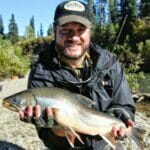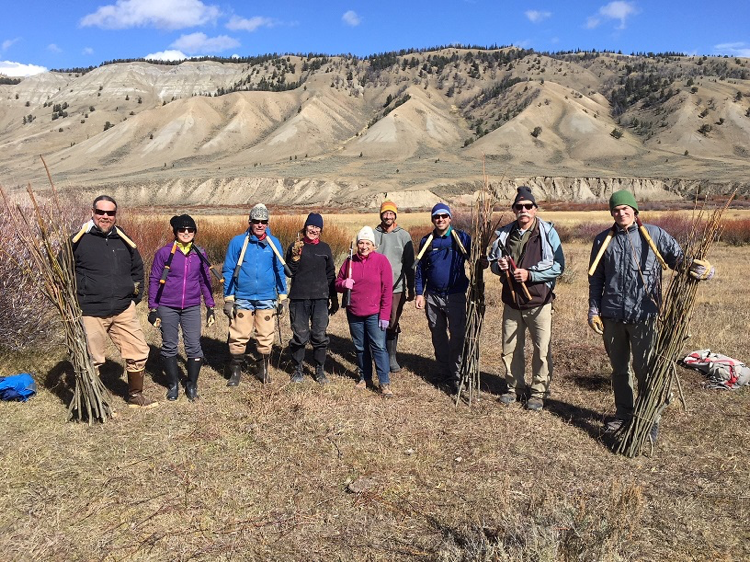Volunteers from the Jackson Hole chapter of Trout Unlimited gathered to help plant willows along a restored section of Unnamed Creek on the Upper Gros Ventre River Ranch Tributary Restoration Project. Trout Unlimited photo.<
/span>
By Leslie Steen
Once the good part of the pavement stops it still takes nearly two hours to travel the 30 miles of winding road up the Gros Ventre river valley to get there. The good pavement soon gives way to a pothole-ridden, axle-eating section of pseudo-pavement, which then turns into a bone-jostling washboard gravel road and, eventually, a rutted dirt road with clay that gets slick when wet.
Rounding the bend after the last guest ranch and seeing the wide, gentle meanders of the Gros Ventre River, the sagebrush-dotted hills and wide-open sky, you sense the home stretch to the Upper Gros Ventre River Ranch is near and the journey feels almost worth it.
I’ve made this trip on many occasions over the past few years and learned to look forward to the moment I could get out of the truck, take a deep breath, and step back in time. Worth it.
My first trip in June 2016 was to lay eyes on the tributary streams that would be the focus of the Upper Gros Ventre River Ranch Tributary Restoration Project, a project led by Trout Unlimited and The Trust for Public Land, but made possible by the help of numerous partners. The Trust for Public Land had been gifted this piece of land deep in the Gros Ventre wilderness — in the headwaters of the Gros Ventre River, a major tributary of the Upper Snake River — in 2015 by former U.S. Senator Herb Kohl of Wisconsin. The Gros Ventre piece was part of a future transfer to the Bridger-Teton National Forest — a visionary land transfer deal that would take several years to complete. In the meantime, Chris Deming, senior project manager for The Trust for Public Land, reached out to see if Trout Unlimited would be interested in helping restore the streams on the property for native Snake River cutthroat trout.
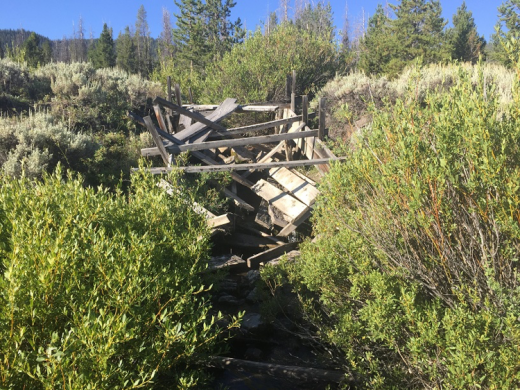
The Common Sense Ditch crossing at Lloyd Creek (above) included an abandoned wooden irrigation sutructue that had a steep drop and was a barrier to fish passge. After it was removed, grade control structures were installed and banks were lined with willow clump transplants (below). Trout Unlimited photos.
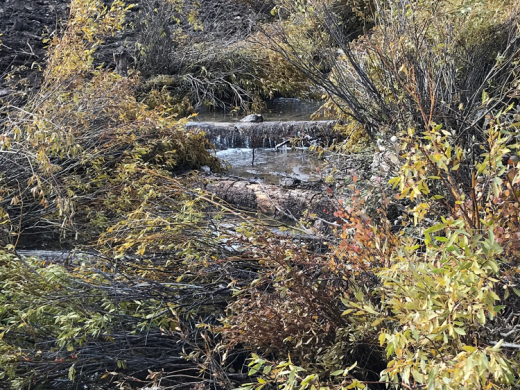
It was hard to get a sense of what was going on with all of the water on the property on that first trip. The 990 acres were vast, and the small tributaries draining the steep hillside to the south, before spilling across the broad valley towards the Gros Ventre river, presented a puzzling mystery as to where the water was coming from — and going – thanks to an elaborate network of decaying irrigation ditches and diversions, phantom channels, and wetlands.
I quickly enlisted the help of the Wyoming Game and Fish Department to better understand what the fisheries potential of the site would have been before it was altered. Some sparse historical fish sampling records and knowledge of other small tributaries in the area provided the conclusion that these small tributaries would have been excellent rearing habitat for juvenile trout, providing types of habitat not readily available in the mainstem Gros Ventre. Electrofishing confirmed what we had already sensed – the streams no longer held trout, likely because they lacked connectivity to the Gros Ventre and didn’t have reliable stream flows.
The Jackson Hole Chapter of Trout Unlimited ponied up the crucial first grant to cover the cost of the project planning and design phase, and we were off and running. Biota Research and Consulting, Inc., a firm based in Jackson, was selected for the design contract, and through background research and field work helped us sleuth out what had happened to these tributary streams, and make a plan for restoration. From upstream to downstream, they were: Jones, Lafferty, and Lloyd, and “Unnamed” Creeks. Despite sounding like a distinguished legal firm, Jones, Lafferty, and Lloyd were actually named after the hardy homesteaders in the area that first started diverting water through an extensive irrigation ditch system in the early 1900s. One of the main ditches, the primary source of impairment for these tributaries, was called the Common Sense ditch. It took off from the mainstem Gros Ventre just upstream of Jones Creek, then followed the base of the hillside, crossing each tributary. Along the way, it intercepted their flow and used their extra input of water, mixed with the Gros Ventre water, to irrigate the hundreds of acres of hay meadow between the hillside and the river through numerous lateral irrigation ditches. Lloyd and Unnamed Creeks had been completely diverted and dewatered for so long that their historical stream channels near the Gros Ventre confluence were nowhere to be found, petering out into shallow swales vegetated by grasses, sagebrush and sulfur cinquefoil – dryland species.
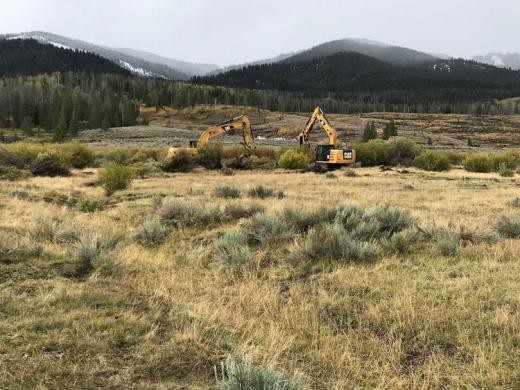
This historic channel section of Lloyd Creek close to the confluence with the Gros Ventre River had been filled in and turned into hay meadow (above). The channel was recreated and stabilized with willows and sod mats. Once flows were restored back into the historic channel Lloyd Creek was once again connected to the Gros Ventre (below). Trout Unlimited photos.
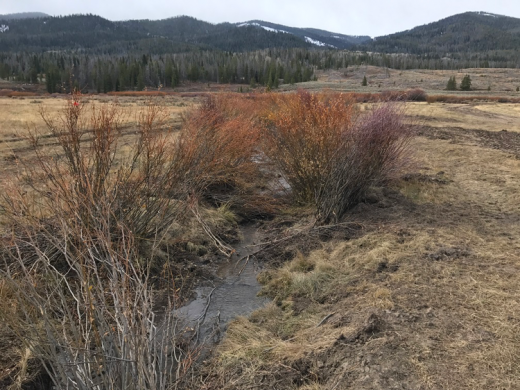
Now, our task was to turn back time and reverse the handiwork of the homesteaders so these streams would once again provide connectivity and habitat for native trout and cold, clean water to the Gros Ventre River before the land transfer to the Bridger-Teton National Forest. Because the irrigation system and their associated water rights had not been in use for decades, and there were no foreseeable plans to reactivate them, our restoration plan focused on “common sense” solutions for each of the tributaries.
First, any old irrigation diversions and structures were removed.
Second, all lateral ditches and ditch crossings off of streams were plugged and revegetated, so that stream flows would be consolidated back in the natural channel.
Third, sections of stream channel that had been degraded were restored.
Fourth, streams that lacked physical connectivity to the Gros Ventre River because the stream channel had all but disappeared were reconstructed and reconnected.
As an added bonus, we would decommission, regrade, and reseed as much of the Common Sense ditch as possible, erasing its mark on the hillside and restoring a natural hydrology.
To turn this vision into reality, we engaged a broad suite of funding partners through grants and personal outreach. The Bridger-Teton National Forest, Community Foundation of Jackson Hole, Jackson Hole One Fly Foundation, Teton Conservation District, The Trust for Public Land, U.S Fish and Wildlife Service, Wyoming Game and Fish Department Habitat Trust Fund, Wyoming Wildlife and Natural Resources Trust, and private donors rallied to support the project to the tune of a quarter million dollars. The value of in-kind partner matching support was estimated to be nearly $50,000.
In 2017, we set our sights on laying the ground work to implement the project by the fall. This meant many more bumpy, nerve-frazzling trips up and down the length of the Gros Ventre road — with the lively college student ambassadors of the TU/Costa 5 Rivers Program, with Wyoming Game and Fish for aquatic habitat and fish sampling monitoring, with a group of Jackson Hole TU volunteers that helped harvest willows for revegetating the project, with project funders excited to see the project in person, with a film crew to capture before-and-after footage of the project, and on my own to check in on the construction contractor team’s progress.
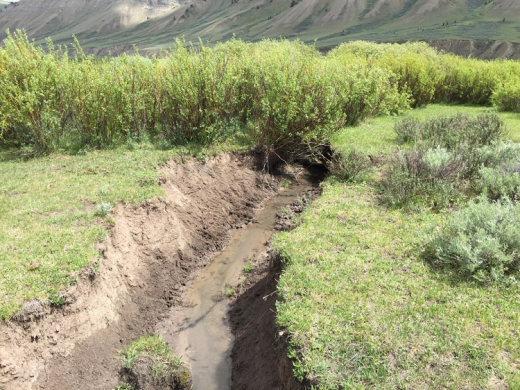
This incised and eroding area of Lloyd Creek (above) was part of the relict historic channel that had been completely dewatered by a series of diversions. The diversions were plugged and flows were consolidated back into the historic channel, which was restored and lined with willow clump transplants (below). Trout Unlimited photos.
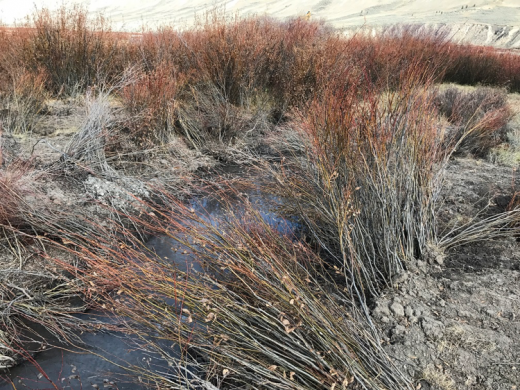
The road continued to be a major factor – especially in the spring, and when we got unseasonably early snow in the high country in mid-September – damaging at least three government vehicles, requiring very active 4-wheel drive tactics and a tow strap, ripping a support strut off of a contractor’s fifth wheel, and numerous other close calls. In addition to being somewhat of a bonding experience, one of the upsides of surviving the Gros Ventre road was the windshield time with project partners and contractors, getting to talk shop and non-shop topics like musical tastes, favorite potato chip brands, upcoming travels, even relationship drama.
By mid-September, permits were finally signed, sealed, and delivered and we were ready to start construction. Our contractor, Oxbow Earthworks, braved the snowy and muddy conditions with an arsenal of track hoes, dump trucks, dozers, culverts, and fencing materials, and by the end of October, the construction phase of the project was officially complete. Some of the most dramatic before-and-after work was on Lloyd Creek, which had been transformed back into a stream through a new channel connecting it to the Gros Ventre River, whole willow transplants providing an instant-gratification riparian zone, the removal of a large, dilapidated wooden irrigation structure, a new culvert properly sized for fish passage and flood flows, and most importantly, a healthy amount of streamflow in place of a bone-dry channel. Another big turn-around was the decommissioning of much of the Common Sense Ditch between Jones Creek and Unnamed Creek, including recontouring and reseeding at a massive slumped area big enough to swallow a few vehicles.
Looking ahead to the summer 2018 field season, I’m excited to see the restoration project after some of the native grasses and willows have had a chance to grow and take root, and to look for signs of cutthroat trout returning to the tributary streams.
I know that I’ll have a few more bumpy trips up the road to do post-project monitoring and document the full scope of the “after” with the film crew. This time, I expect the trip to feel a little different. In mid-March 2018, I heard from our friends at The Trust for Public Land that the land transfer to the Bridger-Teton National Forest had officially gone through – thanks in no small part to their tireless work and $3 million in federal Land and Water Conservation Fund dollars.
Rather than simply being my restoration project area at the end of the Gros Ventre road, I’ll step out of the truck and know that this is now public land – my land, your land, our land. I hope that the others that brave the road to explore and perhaps fish the waters on these 990 acres will cherish the land and its trout streams as the incredible gift to the American people that it is.
Leslie Steen works as the Snake River Headwaters Project Manager for Trout Unlimited. She is based out of Jackson, Wyoming, and can be reached at Leslie.Steen@tu.org


